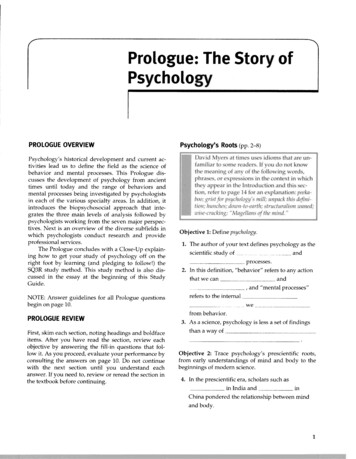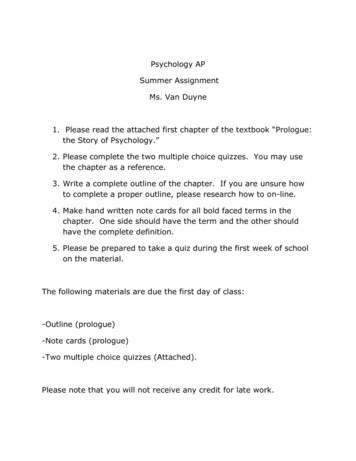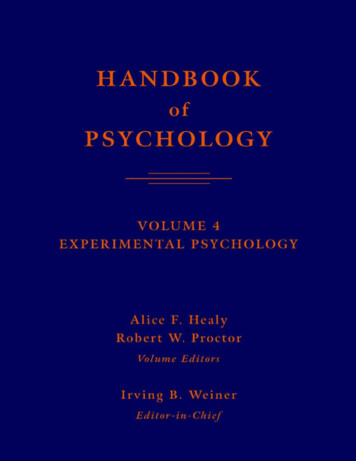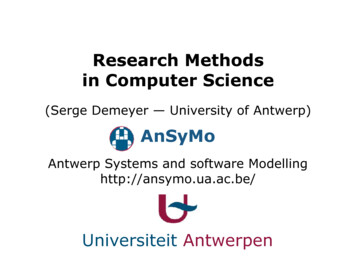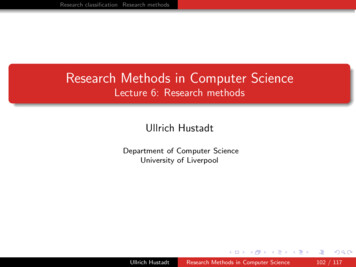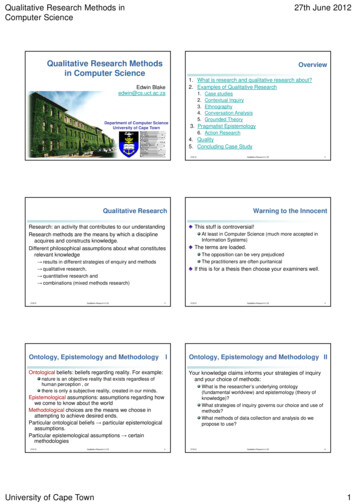
Transcription
Research MethodsPsychology Pack:Year 11
Contents PageRevision Checklist/ SpecificationPage 3-7Experimental methods (Aims, experimental and correlational hypothese, IV/DV )Page 8-11OperationalisationPage 8Experimental methods: lab and field experimentsPage 12Experimental methods: Quasi and Natural experimentsPage 13Control of variablesPage 14Reliability and validityPage 15Experimental designPage 16-17Non experimental methods: Self report – Interviews & questionnaires (inc. designing)Page 18-21Non experimental methods: Observational techniques (inc. designing)Page 22-25Non experimental methods: Case studiesPage 26Non experimental methods: CorrelationPage 27-29Non experimental methods: Content and Thematic AnalysisPage 30SamplingPage 31-33Pilot studies and EthicsPage 34-36Peer ReviewPage 36-37Psychology & the economyPage 37Qualitative & quantitative dataPage 38Primary & secondary data and meta-analysisPage 39Descriptive StatisticsPage 40-42Presentation & display of dataPage 43-46Mathematical content (Percentages, decimals, fractions, ratios)Page 47-49Statistical testing: The sign testPage 50-53Design a studyPage 54-55Practical write ups and Practice exam questionsPage 56 2
The SpecificationResearch Methods: Year 1You will need to be able to demonstrate knowledge and understanding of the following:1.2.3.4.Research methodsScientific processesTechniques of data handling and analysis.It is also important that you’re aware of their strengths and limitations.Notes?Methods and techniquesExperiments 3What is a lab experiment?What are the advantages of a lab experiment?What are the disadvantages of lab experiments?What is a field experiment?What are the advantages of a field experiment?What are the disadvantages of field experiments?What is a natural experiment?What are the advantages of a natural experiment?What are the disadvantages of natural experiments?What is a quasi experiment?What are the advantages of a quasi experiment?What are the disadvantages of a quasi experiment?How to design an experiment.Revised?
Correlational analysis What is a correlational study?What is the difference between correlations and experimentsWhat is a positive/negative correlation?What are the disadvantages of a correlational study?What are the disadvantages of correlational study?How to design a correlationObservational techniques What is an observational study?What is a naturalistic observation? ( advantages and disadvantages)What is a controlled observation? ( advantages and Disadvantages)What is a covert and overt observation? ( advantages and disadvantages)What is a participant and non-participant observation? ( advantages anddisadvantages)How to design an observationSelf report techniques What is a questionnaire? ( advantages and disadvantages)What is an interview?What is a structured interview? ( advantages and disadvantages)What is an unstructured interview? ( advantages and disadvantages)How to design questionnaires and interviews.Case studies What is a case study?What are the advantages of case studies?What are the disadvantages of case studies?Content analysis 4What is a content analysis?What are the advantages of a content analysis?What are the disadvantages of a content analysis?
Investigation design Aims-stating aims,-difference between aims and hypotheses Hypotheses- Directional/one tailed hypothesis- Non-directional/ two tailed hypothesis- Null hypothesis- Operationalised hypotheses Sampling- The difference between population and sample- Opportunity sample ( advantages and disadvantages)- Random sample ( advantages and disadvantages)- Volunteer sample ( advantages and disadvantages)- Systematic sample( advantages and disadvantages)- Stratified sample ( advantages and disadvantages) Pilot studies and the aims of pilot studies Experimental design- Independent groups ( advantages and disadvantages)- Repeated measures ( advantages and disadvantages)- Matched pairs ( advantages and disadvantages) Observational design- Time and event sampling ( advantages and disadvantages)- Behavioural categories? (you must be able to create operationalisedbehavioural categories) Questionnaire construction- The use of open and closed questions ( advantages and disadvantages) Designing interviews Variables-Independent variable-Dependent variable-Co-variables (correlation)- Operationalisation of variables-Extraneous variables (and how they can be controlled)-Confounding variables (and how they can be controlled)5
Control- random allocation & how to do this- counterbalancing & how to do this- randomisation & how to do this- standardisation & how to do this Demand characteristics and investigator effects Ethics- the role of BPS guidelines- ethical issues in the design and conduct of psychological studies- dealing with ethical issues in research The implication of psychological research for the economy Reliability-what is reliability?- definition of inter-rater reliability and how this is used to assess the reliabilityof observations Validity- what is validity?- types of validity – internal and external (ecological, temporal, population)Data handling and analysis Quantitative and qualitative data- the distinction between these data collection techniques Primary and secondary data ( advantages and disadvantages)-including meta-analysis ( advantages and disadvantages) Descriptive statisticsMeasures of central tendency-Mean ( advantages and disadvantages) and calculation-Mode ( advantages and disadvantages) and calculation-Median ( advantages and disadvantages) and calculationMeasures of dispersion-Range ( advantages and disadvantages) and calculation-Standard Deviation ( advantages and disadvantages)Calculation of percentagesPositive, negative and zero correlations Presentation and display of quantitative data-graphs6
-tables-scattergrams-bar charts- histograms Distributions-normal and skewed distributions-characteristics of normal and skewed distributions Analysis and interpretation of correlation, correlation co-efficientsQualitative data analysis - content analysis and thematic analysisIntroduction to statistical testing- calculating of the sign test- interpreting the significance of the sign testIntroductionPsychology is often defined as ‘the science of mind and behaviour’. In order for Psychology to beconsidered a science (and therefore a legitimate academic subject) it has to follow the rules of science.This means that psychologists can’t just come up with ideas that they believe are true, or essentiallyopinions.Psychologists aim to gather evidence about behaviour whilst trying to remain objective and free from bias(personal views). One way this is achieved is through using the scientific method. The scientific method is away of gathering evidence in an orderly, structured manner that can enable psychologists to developtheories and draw conclusions about behaviour.Research methods are a vital component of studying Psychology and this pack will take you through thevarious methods that are used within Psychological research, what kind of data can be gathered and howthe data is analysed. Get ready for the journey!7
Research MethodsExperimental MethodsA variable is anything that canvary, i.e. changed or be changed,such as memory, attention, timetaken to perform a task, etc.Psychologists use the experimental method to identify the "effect" one variable has on other variables. Inother words .does one variable "cause" other variables to change. This is called cause and effect. Beingable to conduct research that establishes cause and effect is a key feature of scientific research.However establishing cause and effect is not easy and requires researchers to conduct studies that notonly follow the scientific method, but also classify as "true experiments".In a true experiment, there must be a control condition and an experimental condition andparticipants must be randomly assigned to these conditions. This is so that the researcher can makefair comparisons between the two groups.A researcher manipulates the independent variable (IV) in order to test its effect on the dependentvariable (DV).Everything else is kept the same (controlled) between the two conditions.If there is a significant difference in the results of the two groups, we can conclude that the independentvariable caused the change in the dependent variable (cause and effect).Independent and dependent variablesIn an experiment, a researcher manipulates the independent variable (IV) and measures the effect ofthis on the dependent variable (DV).All other variables that might potentially affect the DV should remain constant. This means the researchercan be confident that the effect on the DV, was due to the change in the IV and nothing else.Independent Variable: A variable that is manipulated by the researcher – or changes naturally.Dependent Variable: The variable that is measured by the researcher. Any effect on the DV should becaused by changes in the IV.Levels of the IVIn order to test the effect of the IV we need different experimental conditions. The control conditionand the experimental condition. The control condition provides a baseline measure of behaviour without experimental treatment.The experimental condition is the one in which there has been researcher manipulation. This is thecondition in which the researcher is particularly keen to see if a difference in behaviour hasoccurred.OperationalisationPsychologists are interested in a range of behaviour; intelligence, aggression, social anxiety etc. It’simportant when studying them that they are defined.Operationalisation is clearly defining variables so they can be measured.8
Aims and HypothesesBefore a researcher begins to investigate an area of interest, they will write an aim and a hypothesis. Youneed to be able to identify the difference between these and also be able to write both of them.AimThe aim is a general statement of what the researcher intends to investigate, essentially the purpose of thestudy. Aims tend to be developed from theories. For example, this study aims to investigate whetherdrinking energy drinks makes people more talkative.HypothesesOnce the aim is written, the researcher needs to formulate a hypothesis. A hypothesis is a testablestatement predicting the outcome of the study which is made at the start of the study.There are two hypotheses that a written - the alternate/experimental hypothesis and the nullhypothesis Null hypothesis – this predicts that there will be no difference or relationship.Alternate/experimental hypothesis – these predict a difference or relationship and can bedirectional or non-directional.Directional hypothesis (also called a one-tailed hypothesis)The researcher makes it clear what sort of difference or relationship that maybe seen between the 2 conditions. The hypothesis may use words like ‘less’‘more’ ’higher’ or ‘lower’.For example,People who drink redbull will become more talkative than people who don’t.Or People who drink water will be less talkative than people who drinkredbull.Non directional hypotheses (also known as a two-tailed hypothesis)Non-directional hypotheses are used when there has been no previous research to suggest whatdirection the research will go in or the previous findings have been contradictory.Therefore, the researcher simply states there ‘will be a difference’ or ‘there will be a relationship’ between the2 conditions. The direction of the outcome is not mentioned.For example,There will be a difference in talkativeness of people who drink redbull compared with people whodrink water.9
How to write an experimental hypothesis:In order to write a hypothesis there are a few factors you need to be clear on before you can begin.1.2.3.4.5.What are the IV and the DV?How is the IV manipulated e.g. what are the levels of the IVHow has the DV been measured exactly? E.g. how has it been operationalised?Should the hypothesis be one tailed or two tailed?Write your hypothesis- Put it all together!Worked example:The aim is to investigate whether a new drug (axocalm) reduces anxiety in patients with phobias. Noprevious research has been conducted on the effectiveness of this drug.Step 1:Identify the DV- what is being measured? The answer is anxiety.Identify the IV- what is being manipulated? The answer is whether they are given the drug or notStep 2:In order to test the effect of the IV we need different experimental conditions. If we simply gave someparticipants the drug, how would we know if it reduced their anxiety? We need a comparison. We couldeither: Compare participants anxiety levels before and after talking the drug Compare two groups of participants- those who take the drug and those who do not take the drugStep 3:Operationalise the DV- how exactly is anxiety being measured?In this example, they have not specified how anxiety is measured so we need to come up with a sensibleway to measure anxiety e.g. a self report scale.“On a scale of 1-10 (1 not anxious at all and 10 highly anxious) how do you feel now?”Sometimes exam questions will give you information about how the DV has been measured so you need toidentify this from the scenario and include it in your hypothesis.Step 4:Identify from the information you have been given if you should write a one-tailed or two-tailed hypothesis.In this case, they have said that no previous research has been conducted so that informs us that weshould write a non-directional (two tailed) hypothesis.Step 5:Put all of this information together into a written testable statement.Below is an example of a template you can use to write nearly every non-directional hypothesis:There will be a difference in (DV), measured by ( operationalised DV) forparticipants who (IV - condition 1)compared to those who (IV -condition 2).The answer is on the next page.10
Answer:There will be a difference in anxiety, (measured on a self-report s
Experimental methods (Aims, experimental and correlational hypothese, IV/DV ) Page 8-11 Operationalisation Page 8 Experimental methods: lab and field experiments Page 12 Experimental methods: Quasi and Natural experiments Page 13 Control of variables Page 14 Reliability and validity Page 15 Experimental design Page 16-17 Non experimental methods: Self report – Interviews &


